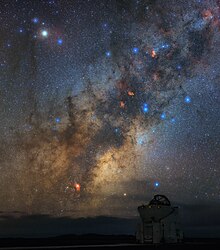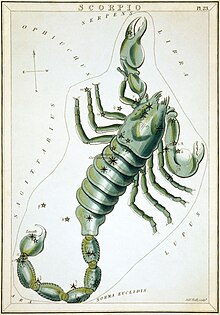| This article needs additional citations for verification. Please help improve this article by adding citations to reliable sources. Unsourced material may be challenged and removed. Find sources: "Scorpius" – news · newspapers · books · scholar · JSTOR (June 2024) (Learn how and when to remove this message) |
| Constellation | |
 List of stars in Scorpius List of stars in Scorpius | |
| Abbreviation | Sco |
|---|---|
| Genitive | Scorpii |
| Pronunciation | /ˈskɔːrpiəs/, genitive /ˈskɔːrpiaɪ/ |
| Symbolism | the Scorpion |
| Right ascension | 16.8875 |
| Declination | −30.7367° |
| Quadrant | SQ3 |
| Area | 497 sq. deg. (33rd) |
| Main stars | 18 |
| Bayer/Flamsteed stars | 47 |
| Stars with planets | 14 |
| Stars brighter than 3.00 | 13 |
| Stars within 10.00 pc (32.62 ly) | 3 |
| Brightest star | Antares (α Sco) (0.96) |
| Messier objects | 4 |
| Meteor showers | Alpha Scorpiids Omega Scorpiids |
| Bordering constellations | Sagittarius Ophiuchus Libra Lupus Norma Ara Corona Australis |
| Visible at latitudes between +40° and −90°. Best visible at 21:00 (9 p.m.) during the month of July. | |
Scorpius is a zodiac constellation located in the Southern celestial hemisphere, where it sits near the center of the Milky Way, between Libra to the west and Sagittarius to the east. Scorpius is an ancient constellation whose recognition predates Greek culture; it is one of the 48 constellations identified by the Greek astronomer Ptolemy in the second century.
Notable features
Stars
See also: List of stars in Scorpius
Scorpius contains many bright stars, including Antares (α Sco), "rival of Mars," so named because of its distinct reddish hue; β Sco (Graffias or Acrab), a triple star; δ Sco (Dschubba, "the forehead"); θ Sco (Sargas, of sumerian origin); ν Sco (Jabbah); ξ Sco; π Sco (Fang); σ Sco (Alniyat); and τ Sco (Paikauhale).
Marking the tip of the scorpion's curved tail are λ Sco (Shaula) and υ Sco (Lesath), whose names both mean "sting." Given their proximity to one another, λ Sco and υ Sco are sometimes referred to as the Cat's Eyes.
The constellation's bright stars form a pattern like a longshoreman's hook. Most of them are massive members of the nearest OB association: Scorpius–Centaurus.
The star δ Sco, after having been a stable 2.3 magnitude star, flared in July 2000 to 1.9 in a matter of weeks. It has since become a variable star fluctuating between 2.0 and 1.6. This means that at its brightest it is the second brightest star in Scorpius.

U Scorpii is the fastest known nova, with a period of about 10 years.
AH Scorpii is a red supergiant star and one of the largest known stars, being 1,400 times larger than the Sun. It is also a luminous star, 340,000 times brighter than the Sun, altought is too faint to be seen to the naked eye, with a brightness varying from 6.5 to 9.6.
The close pair of stars ω Scorpii and ω² Scorpii are an optical double, which can be resolved by the unaided eye. One is a yellow giant, while the other is a blue B-type star in the Scorpius-Centaurus Association.
The star once designated γ Sco (despite being well within the boundaries of Libra) is today known as σ Lib. Moreover, the entire constellation of Libra was considered to be claws of Scorpius (Chelae Scorpionis) in Ancient Greek times, with a set of scales held aloft by Astraea (represented by adjacent Virgo) being formed from these westernmost stars during later Greek times. The division into Libra was formalised during Roman times.
Deep-sky objects

Due to its location straddling the Milky Way, this constellation contains many deep-sky objects such as the open clusters Messier 6 (the Butterfly Cluster) and Messier 7 (the Ptolemy Cluster), NGC 6231 (by ζ² Sco), and the globular clusters Messier 4 and Messier 80.
Messier 80 (NGC 6093) is a globular cluster of magnitude 7.3, 33,000 light-years from Earth. It is a compact Shapley class II cluster; the classification indicates that it is highly concentrated and dense at its nucleus. M80 was discovered in 1781 by Charles Messier. It was the site of a rare discovery in 1860 when Arthur von Auwers discovered the nova T Scorpii.
NGC 6302, also called the Bug Nebula, is a bipolar planetary nebula. NGC 6334, also known as the Cat's Paw Nebula, is an emission nebula and star-forming region.

Mythology
| This section is written like a personal reflection, personal essay, or argumentative essay that states a Misplaced Pages editor's personal feelings or presents an original argument about a topic. Please help improve it by rewriting it in an encyclopedic style. (March 2015) (Learn how and when to remove this message) |

In Greek mythology, several myths associated with Scorpius attribute it to Orion. According to one version, Orion boasted to the goddess Artemis and her mother, Leto, that he would kill every animal on Earth. Artemis and Leto sent a scorpion to kill Orion. Their battle caught the attention of Zeus, who raised both combatants to the sky to serve as a reminder for mortals to curb their excessive pride. In another version of the myth, Artemis' twin brother, Apollo, was the one who sent the scorpion to kill Orion after the hunter earned the goddess' favor by admitting she was better than him. After Zeus raised Orion and the scorpion to the sky, the former hunts every winter but flees every summer when the scorpion comes. In both versions, Artemis asked Zeus to raise Orion.
In a Greek myth without Orion, the celestial scorpion encountered Phaethon while he was driving his father Helios' Sun Chariot.
Origins
The Babylonians called this constellation MUL.GIR.TAB - the 'Scorpion'; the signs can be literally read as 'the (creature with) a burning sting'.
In some old descriptions the constellation of Libra is treated as the Scorpion's claws. Libra was known as the Claws of the Scorpion in Babylonian (zibānītu (compare Arabic zubānā)) and in Greek (χηλαι).
Astrology
Main article: Scorpio (astrology)The Western astrological sign Scorpio differs from the astronomical constellation. Astronomically, the sun is in Scorpius for just six days, from November 23 to November 28. Much of the difference is due to the constellation Ophiuchus, which is used by few astrologers. Scorpius corresponds to the Hindu nakshatras Anuradha, Jyeshtha, and Mula.
Culture
- The Javanese people of Indonesia call this constellation Banyakangrem ("the brooded swan") or Kalapa Doyong ("leaning coconut tree") due to the shape similarity.
- In Hawaii, Scorpius is known as the demigod Maui's Fishhook or Ka Makau Nui o Māui (meaning the Big Fishhook of Māui) and the name of the fishhook was Manaiakalani.
- Scorpius was divided into two asterisms which were used by Bugis sailors for navigation. The northern part of Scorpius (α, β, γ or σ Lib, δ, ε, ζ, μ, σ and τ Scorpii) was called bintoéng lambarué, meaning "skate stars". The southern part of Scorpius (η, θ, ι, κ, λ and ν Scorpii) was called bintoéng balé mangngiwéng, meaning "shark stars".
See also
References
- Knight, J.D. "Constellation Scorpius - The Constellations on Sea and Sky". www.seasky.org. Retrieved 2017-02-11.
- Burnham, Robert (1978-01-01). Burnham's Celestial Handbook: An Observer's Guide to the Universe Beyond the Solar System. Courier Corporation. ISBN 978-0-486-23673-5.
- Fred Schaaf (Macmillan 1988) 40 Nights to Knowing the Sky: A Night-by-Night Sky-Watching Primer, p. 79 (ISBN 9780805046687).
- Preibisch, T.; Mamajek, E. (2009). "The Nearest OB Association: Scorpius–Centaurus (Sco OB2)". Handbook of Star-Forming Regions. 2: 0. arXiv:0809.0407. Bibcode:2008hsf2.book..235P.
- "Delta Scorpii Still Showing Off". Archived from the original on 2007-06-06. Retrieved 2008-06-28.
- "AAVSO: Variable Star of the Season: U Scorpii".
- Arroyo-Torres, B.; Wittkowski, M.; Marcaide, J. M.; Hauschildt, P. H. (2013-06-01). "The atmospheric structure and fundamental parameters of the red supergiants AH Scorpii, UY Scuti, and KW Sagittarii". Astronomy and Astrophysics. 554: A76. arXiv:1305.6179. Bibcode:2013A&A...554A..76A. doi:10.1051/0004-6361/201220920. ISSN 0004-6361.
- Kiss, L. L.; Szabó, Gy. M.; Bedding, T. R. (2006-11-01). "Variability in red supergiant stars: pulsations, long secondary periods and convection noise". Monthly Notices of the Royal Astronomical Society. 372 (4): 1721–1734. arXiv:astro-ph/0608438. Bibcode:2006MNRAS.372.1721K. doi:10.1111/j.1365-2966.2006.10973.x. ISSN 0035-8711.
- Houk, N.; Smith-Moore, M. (1988), Michigan Catalogue of Two-dimensional Spectral Types for the HD Stars. Declinations -26°.0 to -12°.0, vol. 4, Bibcode:1988mcts.book.....H.
- Jilinski, E.; et al. (March 2006), "Radial velocity measurements of B stars in the Scorpius-Centaurus association", Astronomy and Astrophysics, 448 (3): 1001–1006, arXiv:astro-ph/0601643, Bibcode:2006A&A...448.1001J, doi:10.1051/0004-6361:20041614, S2CID 17818058.
- Levy 2005, pp. 166–167.
- Scholia on Homer, Iliad 18.486 citing Pherecydes
- Scorpio - The Legend and Myth Archived 2008-07-20 at the Wayback Machine
- Woolfolk, Joanna (2011). Scorpio. Lanham: Taylor Trade Publishing. p. 81. ISBN 978-1589795600.
- Babylonian Star-lore by Gavin White, Solaria Pubs, 2008 page 175
- Daldjoeni, N (1984). "Pranatamangsa, the javanese agricultural calendar – Its bioclimatological and sociocultural function in developing rural life". The Environmentalist. 4 (S7): 15–18. Bibcode:1984ThEnv...4S..15D. doi:10.1007/BF01907286. S2CID 189914684.
- "Jejak Langkah Astronomi di Indonesia". 2 January 2011.
- "Hawaiian Astronomical Society, Constellations: Scorpius - The Scorpion who Killed Orion".
- "Hawaiian Star Lines and Names for Stars - Star Line 3. Manaiakalani".
- Kelley, David H.; Milone, Eugene F.; Aveni, A.F. (2011). Exploring Ancient Skies: A Survey of Ancient and Cultural Astronomy. New York, New York: Springer. p. 344. ISBN 978-1-4419-7623-9.
- Levy, David H. (2005). Deep Sky Objects. Prometheus Books. ISBN 1-59102-361-0.
- Ian Ridpath and Wil Tirion (2007). Stars and Planets Guide, Collins, London. ISBN 978-0-00-725120-9. Princeton University Press, Princeton. ISBN 978-0-691-13556-4.
External links
- The Deep Photographic Guide to the Constellations: Scorpius
- The clickable Scorpius
- Star Tales – Scorpius
- Warburg Institute Iconographic Database (medieval and early modern images of Scorpius)
| The 88 modern constellations | |
|---|---|
| |
| Constellation history | |||||||||
|---|---|---|---|---|---|---|---|---|---|
| |||||||||
| |||||||||
|
| Zodiac | |
|---|---|
| Astrological signs | |
| Concepts in Western astrology | |
| Related | |